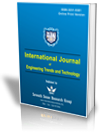Sentiment Analysis and Evolutionary Multimodal Autoencoders for Enhanced Stock Market Volatility Prediction Using Macroeconomic Indicators
Sentiment Analysis and Evolutionary Multimodal Autoencoders for Enhanced Stock Market Volatility Prediction Using Macroeconomic Indicators |
||
 |
 |
|
| © 2025 by IJETT Journal | ||
| Volume-73 Issue-4 |
||
| Year of Publication : 2025 | ||
| Author : Lakshmi Sagar Pulabaigari, C. Sivakumar |
||
| DOI : 10.14445/22315381/IJETT-V73I4P106 | ||
How to Cite?
Lakshmi Sagar Pulabaigari, C. Sivakumar, "Sentiment Analysis and Evolutionary Multimodal Autoencoders for Enhanced Stock Market Volatility Prediction Using Macroeconomic Indicators," International Journal of Engineering Trends and Technology, vol. 73, no. 4, pp. .56-69, 2025. Crossref, https://doi.org/10.14445/22315381/IJETT-V73I4P106
Abstract
Understanding and predicting stock market volatility is crucial for investors and policymakers. Conventional methods have difficulties explaining the fluctuations in frequency between macroeconomic variables and market changes in accounting. A possibly useful method to increase forecasting accuracy is sentiment analysis combined with advanced deep learning models. This work solves frequency mismatches and improves short-term volatility forecasting by means of macroeconomic variables and sentiment analysis. Starting with the treatment of macroeconomic indicators as exogenous variables, the proposed approach treats GDP growth, inflation rates, and interest rates as examples of such variables first. One can estimate investor attitude in sentiment indices by means of the sentiment analysis model that processes market news and social media data. These indices constitute the input for an Evolutionary Multimodal Optimization-based Autoencoder (EMO-AE), which uses macroeconomic variables to derive the output. The EMO-AE enables one to effectively capture nonlinear dependencies and complex patterns, generating a strong representation that can forecast stock market volatility precisely. Macroeconomic considerations taken into account clearly show that the accuracy of weather prediction rises. The model reduces a Root Mean Square Error (RMSE) of 15.2% and a Mean Absolute Percentage Error (MAPE) of 3.7% compared to the traditional methods. This indicates that combining sentiment analysis with DL approaches is a good approach to project the stock market's volatility. The findings highlight the significant role macroeconomic factors and sentiment analysis play in the forecast of the stock market environment. The recommended approach gives investors and financial analysts a more accurate tool for decision-making, thus lowering the related risks connected with market volatility.
Keywords
Stock market volatility, Sentiment analysis, Macroeconomic variables, Evolutionary autoencoders, Forecasting accuracy.
References
[1] Nabanita Das et al., “Integrating Sentiment Analysis with Graph Neural Networks for Enhanced Stock Prediction: A Comprehensive Survey,” Decision Analytics Journal, vol. 10, pp. 1-21, 2024.
[CrossRef] [Google Scholar] [Publisher Link]
[2] Kyung Keun Yun, Sang Won Yoon, and Daehan Won, “Interpretable Stock Price Forecasting Model using Genetic Algorithm-Machine Learning Regressions and Best Feature Subset Selection,” Expert Systems with Applications, vol. 213, 2023.
[CrossRef] [Google Scholar] [Publisher Link]
[3] Ankit Thakkar, and Kinjal Chaudhari, “A Comprehensive Survey on Portfolio Optimization, Stock Price and Trend Prediction Using Particle Swarm Optimization,” Archives of Computational Methods in Engineering, vol. 28, no. 4, pp. 2133-2164, 2021.
[CrossRef] [Google Scholar] [Publisher Link]
[4] Adedoyin Tolulope Oyewole et al., “Predicting Stock Market Movements Using Neural Networks: A Review and Application Study,” Computer Science & IT Research Journal, vol. 5, no. 3, pp. 651- 670, 2024.
[CrossRef] [Google Scholar] [Publisher Link]
[5] Sang Il Lee, and Seong Joon Yoo, “Multimodal Deep Learning for Finance: Integrating and Forecasting International Stock Markets,” The Journal of Supercomputing, vol. 76, no. 10, pp. 8294- 8312, 2020.
[CrossRef] [Google Scholar] [Publisher Link]
[6] Yanli Zhao, and Guang Yang, “Deep Learning-based Integrated Framework for Stock Price Movement Prediction,” Applied Soft Computing, vol. 133, 2023.
[CrossRef] [Google Scholar] [Publisher Link]
[7] Kelvin Du et al., “Financial Sentiment Analysis: Techniques and Applications,” ACM Computing Surveys, vol. 56, no. 9, pp. 1-42, 2024.
[CrossRef] [Google Scholar] [Publisher Link]
[8] Yechan Han, Jaeyun Kim, and David Enke, “A Machine Learning Trading System for the Stock Market Based on N-Period Min-Max Labeling using XGBoost,” Expert Systems with Applications, vol. 211, 2023.
[CrossRef] [Google Scholar] [Publisher Link]
[9] Vijaya Kamble, and Sanjay Bhargava, “Design of an Iterative Method for Enhanced Multimodal Time Series Analysis Using Graph Attention Networks, Variational Graph Autoencoders, and Transfer Learning,” Journal of Electrical Systems, vol. 20, no. 5s, pp. 2579- 2598, 2024.
[CrossRef] [Google Scholar] [Publisher Link]
[10] Tashreef Muhammad et al., “Transformer-Based Deep Learning Model for Stock Price Prediction: A Case Study on Bangladesh Stock Market,” International Journal of Computational Intelligence and Applications, vol. 22, no. 3, pp. 1-16, 2023.
[CrossRef] [Google Scholar] [Publisher Link]
[11] Jitendra V. Tembhurne, and Tausif Diwan, “Sentiment Analysis in Textual, Visual and Multimodal Inputs Using Recurrent Neural Networks,” Multimedia Tools and Applications, vol. 80, no. 5, pp. 6871-6910, 2021.
[CrossRef] [Google Scholar] [Publisher Link]
[12] Man Li et al., “Clustering-Enhanced Stock Price Prediction using DL,” World Wide Web, vol. 26, no. 1, pp. 207-232, 2023.
[CrossRef] [Google Scholar] [Publisher Link]
[13] Jyotirmayee Behera et al., “Prediction Based Mean-Value- At-Risk Portfolio Optimization Using Machine Learning Regression Algorithms for Multi-National Stock Markets,” Engineering Applications of Artificial Intelligence, vol. 120, 2023.
[CrossRef] [Google Scholar] [Publisher Link]
[14] Honey Habib et al., Stock Price Prediction Using Artificial Intelligence Based on LSTM-DL Model, 1st ed., Artificial Intelligence & Blockchain in Cyber Physical Systems, CRC Press, pp. 1-7, 2023.
[Google Scholar] [Publisher Link]
[15] Shahzad Zaheer et al., “A Multi Parameter Forecasting for Stock Time Series Data Using LSTM and DL Model,” Mathematics, vol. 11, no. 3, pp. 1-24, 2023.
[CrossRef] [Google Scholar] [Publisher Link]
[16] Bishnu Padh Ghosh et al., “Deep Learning in Stock Market Forecasting: Comparative Analysis of Neural Network Architectures across NSE and NYSE,” Journal of Computer Science and Technology Studies, vol. 6, no. 1, pp. 68-75, 2024.
[CrossRef] [Google Scholar] [Publisher Link]
[17] Deeksha Chandola et al., “Forecasting Directional Movement of Stock Prices using DL,” Annals of Data Science, vol. 10, no. 5, pp. 1361-1378, 2023.
[CrossRef] [Google Scholar] [Publisher Link]
[18] Yuping Song et al., “Volatility Forecasting for Stock Market Incorporating Macroeconomic Variables based on GARCH‐MIDAS and DL Models,” Journal of Forecasting, vol. 42, no. 1, pp. 51-59, 2023.
[CrossRef] [Google Scholar] [Publisher Link]
[19] B.L. Shilpa, B.R. Shambhavi, “Combined DL Classifiers for Stock Market Prediction: Integrating Stock Price and News Sentiments,” Kybernetes, vol. 52, no. 3, pp. 748-773, 2023.
[CrossRef] [Google Scholar] [Publisher Link]

